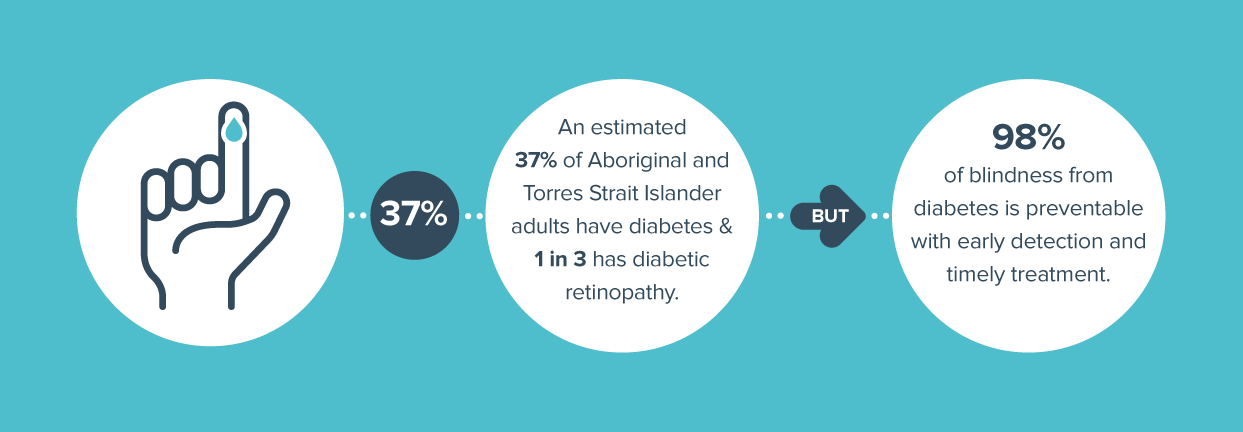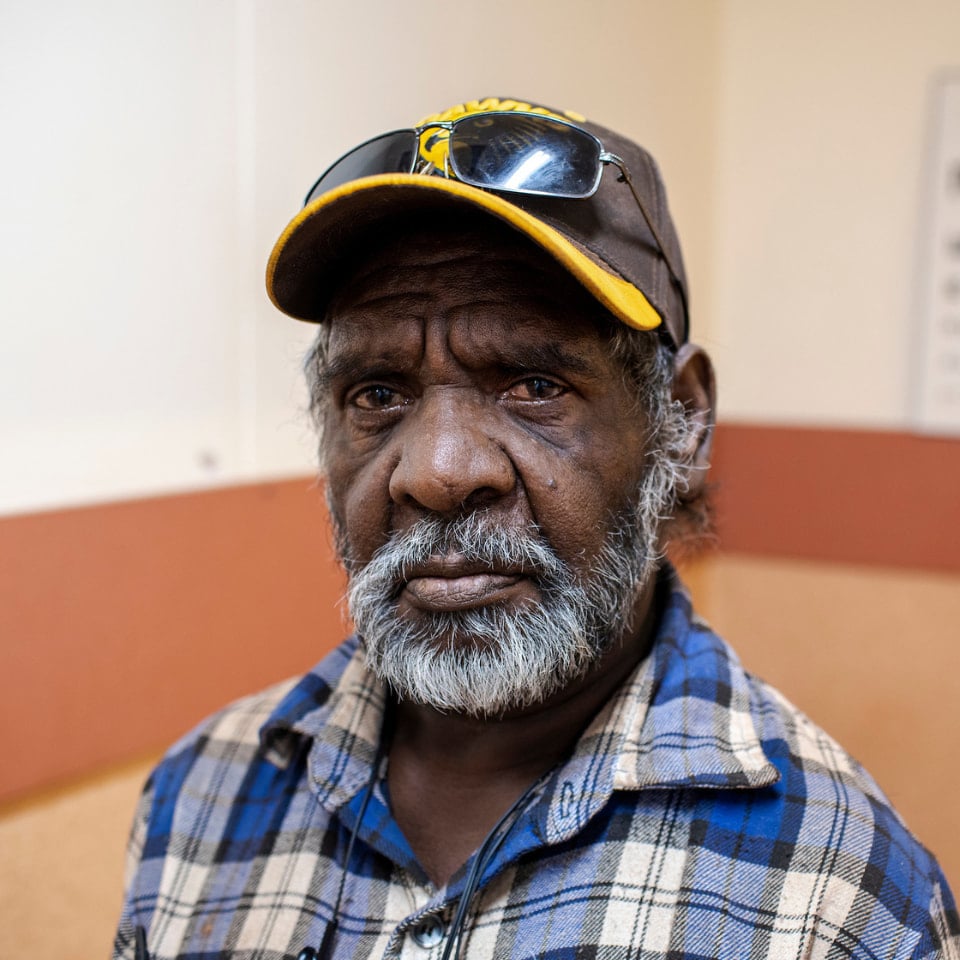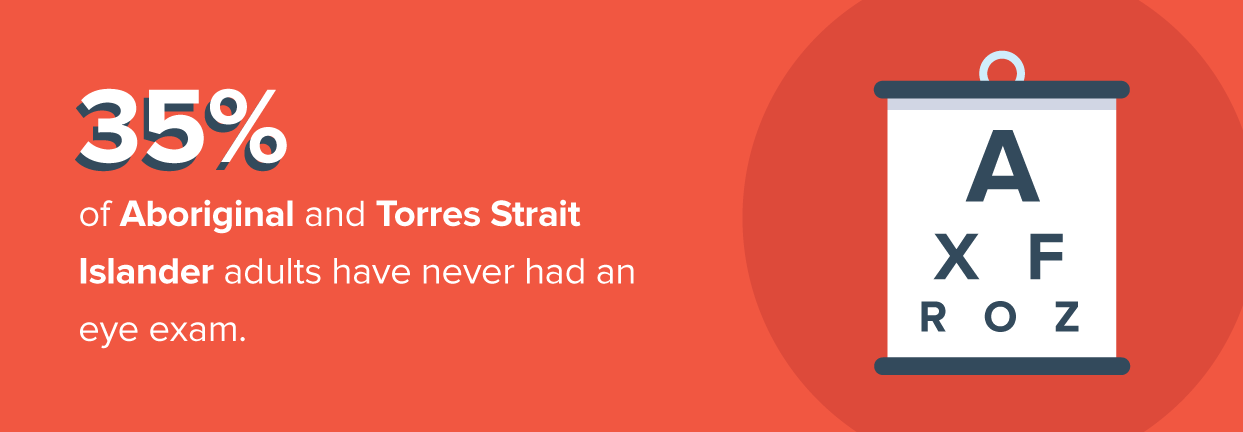Here's what we'll cover...
Click on the link to jump to sections that you're most interested in.
What is diabetic retinopathy?
Diabetic retinopathy (DR) is a complication of diabetes that affects the back of the eye. DR is the world’s leading cause of blindness in the working age population.
Diabetic retinopathy (DR) is a complication of diabetes that affects the back of the eye. DR is the world’s leading cause of blindness in the working age population.
Diabetes occurs when a person's body is unable to effectively regulate glucose levels, and is rising at alarming rates globally. In coming years, diabetes will demand more from Australia's health system than any other condition.
Diabetic retinopathy can affect people with poorly-managed diabetes. This can include people with Type 1, Type 2 and gestational diabetes mellitus (GDM), which is when someone develops diabetes during pregnancy (Australian Indigenous HealthInfoNet, 2018).
Want to know what someone with Diabetic Retinopathy sees? Visit our Sight Simulator.
The blood vessels in the retina can become irreversibly damaged when someone has high and varying blood sugar levels.
It's possible for them to leak or bleed, causing abnormal blood vessels to develop. This can lead to loss of vision and eventually blindness, due to retinal detachment.
The longer that someone has diabetes, the greater the risk of irreversible vision damage from diabetic retinopathy, meaning that early detection and treatment is vital. Patients are also advised to start cultivating healthy eating habits and exercise regularly. In some cases, patients will be prescribed medication to regulate blood sugar, blood pressure and cholesterol levels.

Are you a health professional?
Primary health practitioners play a crucial role in all stages of managing good eye health by facilitating early diagnosis and timely management of diabetic eye disease. We have research and resources available that can help inform your practice.
Download our guide for professionals - Diabetes Eye Health: a guide for Health Professionals.
If you're looking for an introduction into diabetic retinopathy, please visit our online resources.
Diabetes in Aboriginal and Torres Strait Islander people
Occurring at nearly five times the rate of non-Indigenous Australians, diabetes is the second leading cause of death among Australia’s Aboriginal and Torres Strait Islander population.
In 2017, diabetes was the second most common cause of death for Aboriginal and Torres Strait Islander people (Overview of Aboriginal and Torres Strait Islander Health Status 2018).
In 2012-14, there were more than 50,000 Aboriginal and Torres Strait Islander people hospitalised for diabetes, 90 percent of which were for Type 2 diabetes. During that same period, it was found that 11 percent of Indigenous adults were living with a form of diabetes, as well as nearly 5 percent who were at risk of developing diabetes.
What’s more, diabetes is on the rise. In fact, it’s the world’s fastest growing chronic disease.

Diabetes is a huge issue for Australia’s Aboriginal and Torres Strait Islander population, making up 5.5 percent of the total burden of disease.
The vast majority of diabetes-related issues, like diabetic retinopathy, stem from cases of Type 2 diabetes (92 percent). Type 2 diabetes often occurs for years undetected in our Aboriginal and Torres Strait Islander population.

Type 2 diabetes in Aboriginal and Torres Strait Islander people
Type 2 diabetes develops over a long period of time. Before receiving a diagnosis of Type 2 diabetes, a person will go through a phase of ‘pre-diabetes’, or ‘impaired fasting glycemia’ (IFG). This is where the patient’s blood glucose levels are higher than healthy levels.
If doctors detect IFG early enough, they can work with their patients to develop healthy eating and exercise habits. In most cases, this will be enough to prevent the condition worsening to diabetes.
Untreated diabetes can be very harmful to our eyes
Undetected diabetes can be harmful to our eyes. Irreversible retinal damage can occur for months or even years without detection and treatment.
The National Health and Medical Research Council guidelines recommend yearly eye examinations for people with diabetes, which include a retinal examination and vision tests, as well as medical history discussions and further specialist referral if needed.
The National Eye Health Survey (2017) found that the rates of yearly eye checks for Aboriginal and Torres Strait Islander Australians are rising, with 53 percent of Aboriginal and Torres Strait Islander peoples with diabetes receiving their yearly eye checks (compared with 78 percent non-Indigenous).
But as you can see, this means that nearly half of all diabetes patients are not receiving their vital yearly eye health checks. This is something that The Fred Hollows Foundation is working to improve.

Video resource: 'Bad sugars - bad eyes'
This animated video, 'Bad sugars, bad eyes' was produced by Lions Outback Vision, to explain the key facts about diabetes and diabetic retinopathy, specifically adapted for Aboriginal and Torres Strait Islander people.
It emphasises the importance of regular eye health screening and early intervention for those with or at risk of developing diabetes.
Thanks to the Australian Indigenous HealthInfoNet for their extensive resource library, which is where we found this fantastic video.
Diabetic Retinopathy in Aboriginal and Torres Strait Islander people
Diabetic retinopathy (DR) is one of the main causes of vision impairment, behind uncorrected refractive error, cataract and age-related macular degeneration. DR makes up around 5.5 percent of vision impairment in the Aboriginal and Torres Strait Islander population but much less, 1.5 percent, for non-Indigenous Australians (National Eye Health Survey Report, 2017).
As many as 1 in 10 Aboriginal and Torres Strait Islander adults with diabetes have vision impairment due to DR. That’s twice as likely as non-Indigenous Australians.
Both Type 2 diabetes and DR can be prevented with careful treatment and support for those with diabetes, or at risk of developing it.
Unfortunately, once the damage is done to the eye, it cannot be repaired, highlighting the importance of prevention.
Since I have been taking care of my diabetes, I have lots more energy to be with my family. But I really want to get back to work. I was a ranger with the Mary River group. I want to get back on country again like when I was a ranger
Diabetic retinopathy among Aboriginal and Torres Strait Islander people
This short animated video about diabetic retinopathy (DR) was co-designed by the Australian Indigenous HealthInfoNet and The Fred Hollows Foundation and is part of a collection of new multimedia resources about DR.
Above blurb is adapted from the Australian Indigenous HealthInfoNet's YouTube Channel
The Australian Indigenous HealthInfoNet is based at Edith Cowan University in Western Australia, and is a massive web resource that informs practice and policy in Aboriginal and Torres Strait islander health.
Disclaimer: The content on this page is not intended to be medical advice. For medical advice, please contact your local health professional. All statistics quoted use the most recent information available, to the best of our knowledge.